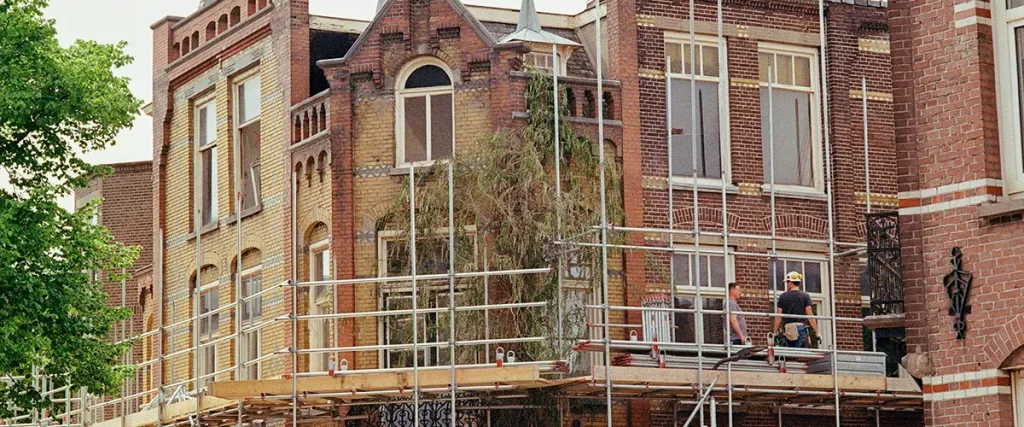New Brunswick’s streets are lined with history, from century-old brick facades to charming colonial storefronts that have seen generations of Rutgers students and local families come and go. If you’re lucky enough to own or lease space in one of these historic properties, you already know they come with undeniable character. But renovating them? That’s a whole different story.
Whether you’re planning to open a business, upgrade residential units, or modernize the infrastructure of a beautiful old building, historic renovations require a special balance. You have to honor the past while creating something functional and up-to-code for today.
This blog post breaks down everything you need to know about renovating historic buildings in New Brunswick, NJ, including what approvals you need, how to work with the Historic Preservation Commission, and how to modernize without losing the charm that makes your building unique.

Renovating a Historic Building Isn’t Like a Regular Renovation
If you’ve renovated newer spaces before, you’re probably used to a more predictable process. But historic buildings come with a unique set of rules, and in New Brunswick, those rules are taken seriously, especially if your property is located in one of the city’s Historic Districts.
These areas are protected by local ordinances designed to preserve the character and integrity of the neighborhood. That means your renovation isn’t just about making updates, it’s about telling the building’s story correctly.
Is Your Property in a Historic District?
Before picking up a hammer or filing a permit application, you need to know if your property is in a designated historic area. In New Brunswick, this includes parts of:
- Livingston Avenue Historic District
- College Avenue area near Rutgers
- Downtown commercial buildings with historic storefronts
You can check your property’s status by contacting the New Brunswick Historic Preservation Commission or calling the City’s Planning Department.
What Does “Preservation” Really Mean?
In practice, preserving a historic building doesn’t mean freezing it in time. It means making thoughtful changes that respect the building’s original architecture, materials, and significance.
That might include:
- Repairing (not replacing) original windows
- Using historically appropriate materials
- Preserving unique brickwork, cornices, or ironwork
- Keeping façade elements visible from the street intact
- Following architectural guidelines for additions or rooftop structures
Modern updates are allowed, but they must be done in a way that maintains the building’s historic identity, especially on visible exterior elements.

The Historic Preservation Approval Process
You’ll need to go through an extra layer of review if your building is in a historic district. Here’s how it works:
Step 1: Submit a Certificate of Appropriateness (COA) Application
This form is reviewed by the Historic Preservation Commission. It includes:
- Details of the planned renovations
- Architectural drawings or photos
- Lists of materials to be used
Step 2: Attend a Public Hearing
You or your architect/contractor will need to present your plans to the Commission. They’ll assess whether your renovation respects the historic nature of the property.
Step 3: Get Approval (Or Feedback)
The Commission can approve your COA, request changes, or deny the application. Once approved, you can move forward with applying for regular building permits.
Modernizing Without Losing Historic Character
Here’s where the magic happens, bringing your space into the 21st century while respecting its past. These are some common updates that can be done tastefully:
Electrical & Plumbing Upgrades
Behind the walls, anything goes. You can install modern systems as long as they don’t alter protected surfaces or structures.
HVAC & Insulation
Energy efficiency matters, but not at the expense of visible features. Mini-split systems are a great low-impact option for historic buildings.
Kitchens & Bathrooms
You can modernize interiors entirely as long as no protected architectural features are removed or altered in the process.
Accessibility
Adding ramps, elevators, or ADA-compliant restrooms is often required. These can be integrated thoughtfully, especially if they’re placed at the rear or interior of the building.

Trusted Manufacturers for Historic Renovation Materials
Using the right materials helps you stay compliant with preservation rules and keeps your building looking authentic.
Top manufacturers include:
- Marvin Windows – Specializes in custom historic wood windows with modern energy ratings
- Salvage One – Offers reclaimed wood, doors, and fixtures appropriate for restoration work
- Benjamin Moore Historical Colors Collection – Period-accurate paint colors for interior and exterior
- Boston Valley Terra Cotta – Known for architectural terra cotta pieces used in façade restorations
- Fireclay Tile – Great for period-style tiles that meet modern safety standards
Our Team Has Been Helping Clients Modernize Historic Buildings for Years
We understand New Brunswick’s permitting process, preservation board requirements, and how to strike that tricky balance between old and new.
Whether you’re updating a retail storefront downtown or retrofitting a historic brownstone near Rutgers, we have the experience and the relationships to make your project happen smoothly and legally.
Frequently Asked Questions
Can I replace my old windows with new ones?
Yes, but only if they match the original appearance. Many times, the Historic Commission will ask that you repair rather than replace, especially if the windows are visible from the street.
Do I need to use original materials in the renovation?
Not always. You can use modern materials that mimic historic ones. The key is visual consistency and durability.
Is interior work regulated too?
Usually, the Historic Commission only regulates the exterior. However, some elements like staircases, trim, or fireplaces might be protected if they’re part of a historic designation.
What if my building isn’t officially historic but looks old?
You may still need review if it’s located in a designated district. Always check with the city before starting any work.
Do I need a separate permit for preservation work?
Yes. You’ll need a Certificate of Appropriateness before applying for standard permits.
Can I paint the outside of my building any color I want?
Nope. In historic districts, paint colors are often regulated. Use period-appropriate palettes and submit your color choices for approval.
How long does it take to get historic approval?
Plan on 3–6 weeks. It can be quicker for minor changes, but larger renovations may take longer if multiple reviews are needed.
Can I install solar panels or other green upgrades?
Possibly. You’ll need to show that they won’t alter the building’s appearance from the street or damage original materials.

Final Thoughts: Honor the Past, Build for the Future
Renovating a historic building in New Brunswick is a rare opportunity. Yes, it takes more effort, more approvals, and a little more patience but the payoff is worth it. You get to preserve a piece of the city’s history while making it useful for today.
By following the rules, working with experienced professionals, and choosing the right materials, you’ll end up with a space that stands the test of time again.
Want help making your commercial project happen the right way? Contact us at (732) 913-0742 to schedule a consultation. Let’s bring your historic renovation project to life without the headaches.
